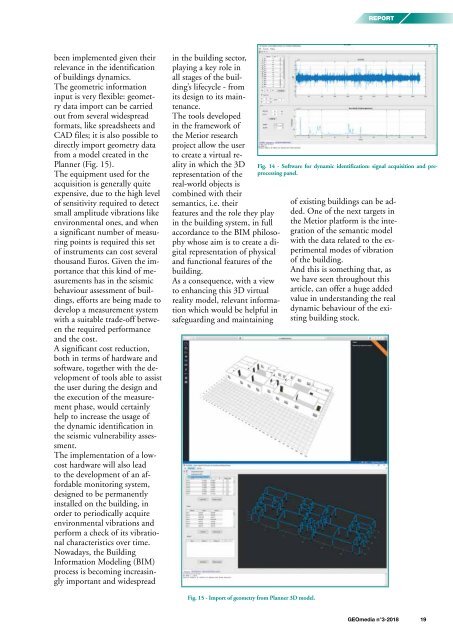GEOmedia_3_2018
GEOmedia - the first Italian magazine on geomatics
GEOmedia - the first Italian magazine on geomatics
You also want an ePaper? Increase the reach of your titles
YUMPU automatically turns print PDFs into web optimized ePapers that Google loves.
REPORT<br />
been implemented given their<br />
relevance in the identification<br />
of buildings dynamics.<br />
The geometric information<br />
input is very flexible: geometry<br />
data import can be carried<br />
out from several widespread<br />
formats, like spreadsheets and<br />
CAD files; it is also possible to<br />
directly import geometry data<br />
from a model created in the<br />
Planner (Fig. 15).<br />
The equipment used for the<br />
acquisition is generally quite<br />
expensive, due to the high level<br />
of sensitivity required to detect<br />
small amplitude vibrations like<br />
environmental ones, and when<br />
a significant number of measuring<br />
points is required this set<br />
of instruments can cost several<br />
thousand Euros. Given the importance<br />
that this kind of measurements<br />
has in the seismic<br />
behaviour assessment of buildings,<br />
efforts are being made to<br />
develop a measurement system<br />
with a suitable trade-off between<br />
the required performance<br />
and the cost.<br />
A significant cost reduction,<br />
both in terms of hardware and<br />
software, together with the development<br />
of tools able to assist<br />
the user during the design and<br />
the execution of the measurement<br />
phase, would certainly<br />
help to increase the usage of<br />
the dynamic identification in<br />
the seismic vulnerability assessment.<br />
The implementation of a lowcost<br />
hardware will also lead<br />
to the development of an affordable<br />
monitoring system,<br />
designed to be permanently<br />
installed on the building, in<br />
order to periodically acquire<br />
environmental vibrations and<br />
perform a check of its vibrational<br />
characteristics over time.<br />
Nowadays, the Building<br />
Information Modeling (BIM)<br />
process is becoming increasingly<br />
important and widespread<br />
in the building sector,<br />
playing a key role in<br />
all stages of the building’s<br />
lifecycle - from<br />
its design to its maintenance.<br />
The tools developed<br />
in the framework of<br />
the Metior research<br />
project allow the user<br />
to create a virtual reality<br />
in which the 3D<br />
representation of the<br />
real-world objects is<br />
combined with their<br />
semantics, i.e. their<br />
features and the role they play<br />
in the building system, in full<br />
accordance to the BIM philosophy<br />
whose aim is to create a digital<br />
representation of physical<br />
and functional features of the<br />
building.<br />
As a consequence, with a view<br />
to enhancing this 3D virtual<br />
reality model, relevant information<br />
which would be helpful in<br />
safeguarding and maintaining<br />
Fig. 14 - Software for dynamic identification: signal acquisition and preprocessing<br />
panel.<br />
of existing buildings can be added.<br />
One of the next targets in<br />
the Metior platform is the integration<br />
of the semantic model<br />
with the data related to the experimental<br />
modes of vibration<br />
of the building.<br />
And this is something that, as<br />
we have seen throughout this<br />
article, can offer a huge added<br />
value in understanding the real<br />
dynamic behaviour of the existing<br />
building stock.<br />
Fig. 15 - Import of geometry from Planner 3D model.<br />
<strong>GEOmedia</strong> n°3-<strong>2018</strong> 19


















